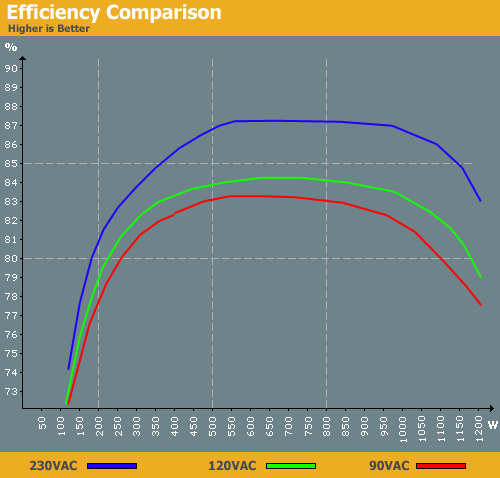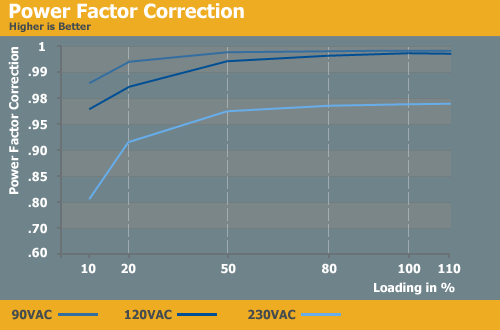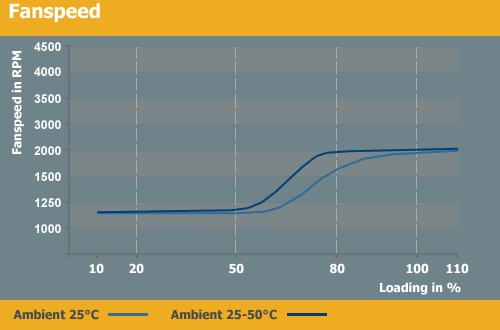Xigmatek NRP-HC1001 and NRP-HC1201 Power Supplies
by Christoph Katzer on April 13, 2008 12:00 PM EST- Posted in
- Cases/Cooling/PSUs
Efficiency

We are including two different graphics of efficiency. The first shows the efficiency at the load percentages and the second shows the efficiency at the different wattage outputs. The second one gives users a better comparison to other power supplies. If you know the amount of power your system requires, you can look up that load in the table below and see what efficiency the power supplies will provide.


Not long ago a power supply company came to us and urged us to use the 80Plus table to load the power supplies instead of the ATX norm. The 80Plus table only looks at 20%, 50% and 100% of load which is quite narrow minded in our opinion and not really useful for our range of tests at all. An important factor is left out and that it where most system run, most of the time: around 10% of their maximum output in idle mode (at least on larger PSUs). Even though both calculation tables both look similar, we will still stick to the ATX norm which just makes more sense.
The efficiency of these two models is very good and the graphs show that users with a huge power usage will benefit most in energy savings. From 500W upwards, power output on these two units reaches an efficiency of 87% at 230VAC. In the US and other locations that use 115VAC, these units still run with a maximum efficiency of up to 84% over a large range of load. For users that run at less than 500W of load (most of the time), these power supplies won’t make much economic sense since you can buy a unit with a lower output rating and save a lot of money.
Power Factor Correction

As always the power factor correction is much better with lower input voltage. This unit covers more than .99 (PFC) even with the lower loads. People in Europe need to be happy with an average result of .98 (PFC) tops.
Fan Speed and Acoustics


Both of the units are clearly audible while running even at the lowest load, or in fact with no load at all. The fan runs with a minimum of 1200RPM, which should not be necessary as a minimum. The noise levels therefore start at 21dB(A), but listening to the fan it seems much louder than that. With increased loads, the fan quickly starts to spin faster past the 50% load mark, and beyond 650W it's quite loud. The highest result we measured was 33dB(A) with a fan speed of 2000RPM. That's still a reasonable result but again we have to add that the sound coming from the power supply seems much louder than the 33dB(A) we’ve heard before from other units.










20 Comments
View All Comments
mttcrlsn - Wednesday, April 16, 2008 - link
When will people wise up that probably 90% do not need anything more than a good, correctly rated PSU. Even when I was doing SLI on an 8800GTS system I maxed out at about 500W. Processors were once space heaters and power hogs but that has done a 180 turn as people wanted computers to be better. Soon GPUs will be doing the same, storage is already getting more power efficient and memory is as well. This idea of marketing of uber high power supplies is going to end soon and may already be ending as the cost of energy heads to the sky. So as some companies continue to beat the dead horse others are now marketing power efficiency and quietness - who wants to work next to a 747 pushing out heat in their office?royalcrown - Sunday, April 20, 2008 - link
Amen to that ! As a side mote...it is good to see GPUs FINALLY getting off of the 90nm mode ! They also need to put the crap on the top side as hot air rises...duh, why do they keep putting the hot side towards the FLOOR ?!michal1980 - Monday, April 14, 2008 - link
lets save you are on a 15 amp circuit.if you have perfect 120v power= 15ax120v = 1800wats. at 85% efficeny = 1530 watt power supply
it its 110 volts = 15x110 = 1650watts = 1402 watt power supply.
dont plug your monitor/speakers/ lights on that cirucit or your going to start blowing fuses.
royalcrown - Sunday, April 20, 2008 - link
it's not a wise idea to plug something in with 2 cords as you have risks if each cord is on a separate circuit, you risk having a voltage potential (greater charge on 1 side of the circuit) and that CAN be unsafe...strikeback03 - Tuesday, April 15, 2008 - link
I'll check when I get home, but I don't think anything in our house is less than a 20A breaker. And a 20A breaker won't typically trip till somewhere over 30A is drawn through it, so you still have some margin for more ridiculous power supplies.mttcrlsn - Wednesday, April 16, 2008 - link
Typical home wiring is 14 gauge with a 15amp max - NO EXCEPTIONS. In order for one to use a 20amp then the wire must be 12 gauge. This is the per the NEC. If it is a 120V 20A receptacle, one side will have a slot, the other will have a "T". As for getting 30A on a 20A breaker - I would get rid of that breaker as it is not rated correctly / is defective.HOOfan 1 - Monday, April 14, 2008 - link
Like this one?http://www.newegg.com/Product/Product.aspx?Item=N8...">http://www.newegg.com/Product/Product.aspx?Item=N8...
nubie - Monday, April 14, 2008 - link
Well, I was wondering something similar, and that is why don't we run dedicated 220v to the PC in our houses here in the US?Even if we don't use all of the power, all of our devices will be running more efficiently. If you have a direct line to your PC already you can change the outlet and add a circuit breaker (that connects to the other bus-bar) for making 220v.
In reality, notice what they already said, they are running a clocked quad with lots of hard drives and tri-sli 8800 Ultra on a PC Power 860.
I agree with them, you can't load it more than 500w (idle?), even with an extreme system like that. You are really just spinning up all those hard drives and charging all those caps when you start the PC (SATA with delayed spin-up?).
I am still using my PC Power Silencer 470, and wondering why it isn't rated for SLi, clearly it can do it, and probably overclocked with a couple hard drives. If you take a second look at those PC-Power ads, they are telling the truth. Their components are industrial grade, and rated for high load + high temps. I don't mean to say that their competitors can't handle a load, but my Silencer has never ramped up, I never even hear it over my hard drive, and this is a pretty nice one from a Tivo2.
B3an - Monday, April 14, 2008 - link
Dont know if it was mentioned in the article because i hardly read any, but from the pics, these PSU's look exactly like the Thermaltake ToughPower PSU's. I have a 1200w ToughPower and as far as i can see there is no difference between them.So WTF is going on? Same PSU but rebadged?
C'DaleRider - Monday, April 14, 2008 - link
Both the Thermaltake ToughPower supply you have and the Xigmatek in this review are both rebadged CWT builds, which is why yours and this one look alike. Tt and Xigmatek are the rebadgers, CWT is the maker. It's just like Seasonic is the manufacturer of numerous other branded power supplies like Corsair's HX line and PC Power and Cooling's Silencer line. Open up a Seasonic, Corsair HX, and a PCP&C Silencer and you'll find, outside fan arrangement and heatsink choices for the fan arrangements, almost mirror image power supplies.